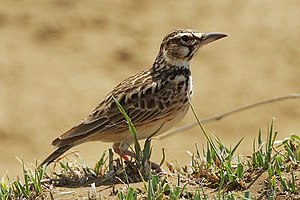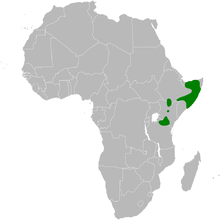Bearded Lark
| Bearded Lark | ||||||||||||
|---|---|---|---|---|---|---|---|---|---|---|---|---|

|
||||||||||||
| Systematics | ||||||||||||
|
||||||||||||
| Scientific name | ||||||||||||
| Spizocorys Fremdantlii | ||||||||||||
| ( Shelley , 1902) |
The bearded lark ( Spizocorys Fremdantlii ) is a small, short-tailed species from the lark family. It is about 20 percent smaller than a skylark , but has a relatively longer beak compared to it. The distribution area of the bearded lark is the east of Africa. There are three subspecies.
The stock situation of the bearded lark was classified in the IUCN's Red List of Threatened Species as “ Least Concern (LC) ” = “not endangered”.
features
The barbed lark reaches a body length of about 14 centimeters, of which between 3.7 and 4.5 centimeters are on the tail. The beak measures between 1.8 and 2 centimeters from the skull. There is no gender dimorphism .
The vertex of the bearded lark is yellow-brownish with dark brown dashes. The coat, the back and the rump are dark brown, the individual feathers are broadly lined with light gray, which creates a striped appearance. The upper tail-coverts are of the same color, but the dotted lines are less pronounced.
The eye is framed by a bright orbital ring, and a bright stripe above the eye runs above the eye. A dark brown stripe runs from the upper beak over the eye and delimits the ear covers. Below the eye there is a small white spot, behind it a dark brown stripe on the cheeks, which is bordered by a blackish stripe of beard. The ear covers are brown and are bordered at the bottom by a light neck collar. The chin and throat are white, the upper chest is whitish-yellow-brown with small tear-shaped brown spots. The belly and the lower tail-covers are whitish with a yellow-brown to reddish-brown tinge.
The wings of the hand and arm are gray-brown with narrow pale hems. The tail feathers are dark brown, the middle pair of control feathers is lined with white, the outermost control spring has a white outer flag. The upper beak is dark gray, while the lower beak is whitish yellow.
Possible confusion
In the distribution area of the bearded lark, both the crested lark and the theklark can be found. The bearded lark differs from the two species by the beard stripe, the white portion in the tail plumage and the lack of a feather bonnet.
Distribution area and habitat
The distribution area of the bearded lark is the east of Africa. They occur in the south and east of Ethiopia, Somalia, and from north and south Kenya to northern Tanzania. The bearded lark is a resident and line bird in the entire distribution area .
The habitat of the barbed lark are short-grass areas, including coastal grassland as well as open shrubland and open, rocky forest areas.
Way of life
The habits of the bearded lark have not yet been conclusively investigated. It mainly feeds on grass seeds and tubers.
Like all larks, the bearded lark is a ground breeder. She builds the open, bowl-shaped nest under the protection of a tuft of grass. The clutch consists of two to four eggs.
Subspecies
There are three subspecies:
- S. f. Fremdantlii ( Lort Phillips , 1897) - nominate form , occurs from southeast Ethiopia to Somalia.
- S. f. megaensis ( Benson , 1946) - found in southern Ethiopia and northern Kenya.
- S. f. delamerei ( Sharpe , 1900) -
Originally described as a separate species, this subspecies occurs in southern Kenya and northern Tanzania.
literature
- Rudolf Pätzold : The larks of the world. Westarp Sciences, Magdeburg 1994, ISBN 3-89432-422-8 .
- Rudolf Pätzold: Compendium of Larks. All the larks on earth. Jan-Schimkat-Medienpublikation, Dresden 2003, ISBN 3-00-011219-7 .
Web links
- Singing of the Bearded Lark on Xeno-Canto
- Spizocorys fremantlii in the endangered Red List species the IUCN 2016 Posted by: BirdLife International, 2016. Accessed February 25 2017th
Single receipts
- ^ Pätzold: Compendium of Larks . P. 303.
- ↑ Spizocorys fremantlii in the endangered Red List species the IUCN 2016 Posted by: BirdLife International, 2016. Retrieved on 9 October 2017th
- ↑ a b Pätzold: Compendium of Larks . P. 302.
- ^ IOC World Bird List 6.4 . In: IOC World Bird List Datasets . September. doi : 10.14344 / ioc.ml.6.4 .
